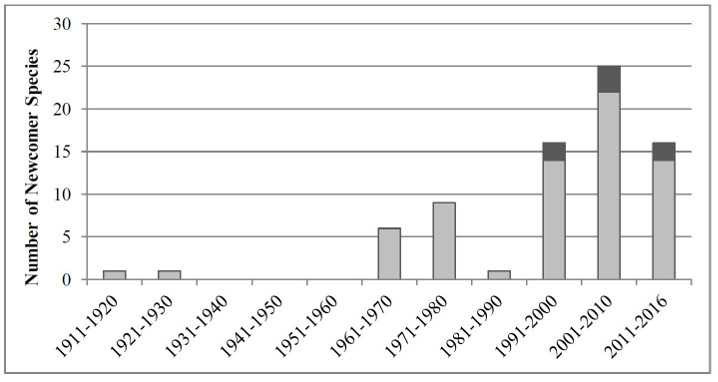

In 2008, the Mediterranean Science Commission (CIESM: Commission Internationale pour l'Exploration Scientifique de la Mer Méditerranée) launched a programme called Tropical Signals with the aim of detecting, monitoring and understanding the effects of climate warming on Mediterranean marine biodiversity using representative biological indicators of change.
The Marine Ecology Research Group (MERG) at the Department of Biology of the University of Malta was invited to form part of this programme because of its track record of research on species and habitats in Maltese waters, and was given the role of implementing in Malta the biological monitoring protocols designed by the 'Tropical Signals' participants (presently 21 research teams from 15 different countries) for common application in all participating countries. The entry and spread of non-indigenous and other newcomer species in the Mediterranean has been linked to a changing marine environment, and monitoring such species is an important component of the 'Tropical Signals' programme.
A first task that needed to be carried out was an inventory of non-indigenous and other newcomer species reported from Maltese waters to act as a baseline for future comparisons. Towards this end, an extensive survey of the scientific and other literature and of authenticated but unpublished reports of alien and newcomer marine species recorded from the Maltese Islands and surrounding waters was made. From this review it resulted that up to the start of the ‘Tropical Signals’ programme (early 2008), 39 authenticated newcomer species and another nine unconfirmed ones, had been recorded from Maltese waters. Of the accepted records, 25 had become established, that is, they are present as reproducing and self-perpetuating populations in the wild. The rest were either casual (only recorded once or twice and have not established breeding populations) or questionable (species for which insufficient information exists to decide if they are established or casual). The most represented groups were molluscs (14 species), fish (13 species) and macrophytes (seagrasses and large seaweeds; 10 species). Six species were classified as invasive in Maltese waters, that is, species whose population has undergone a very rapid growth phase and which may affect the diversity or abundance of native species and the ecological stability of the ecosystem.
Analysis of when each of the newcomer species was first reported from the Maltese Islands, and of their known or probable mode of arrival, showed that since the early 1990s, there has been an increasing trend in the number of marine newcomer species reported, with more than half the species being recorded since 2001.
Since the start of the ‘Tropical Signals’ programme additional non-indigenous and other newcomer species have been reported from Maltese waters by workers from the Marine Ecology Research Group and by others. Up to February 2016, the total number of newcomer species in the Maltese waters (that is, alien and range-extending species) amounted to 80. Eight of these (9% of all newcomers) are considered to have extended their range naturally and hence do not fall under the definition of 'alien species', which are those introduced directly or indirectly through human agency.
Of the species considered aliens (or putative aliens but with uncertain origin), the dominant taxonomic groups are Mollusca (21 species), Actnopterygii (15 species), Crustacea (8 species), and Rhodophyta (7 species).
Some 40% of alien introductions have occurred via unknown pathways; the rest were primarily introduced via shipping (24%), followed by 'Secondary dispersal' (19%), and aquaculture and the aquarium trade (8%). 'Secondary dispersal' refers to species introduced in Maltese waters through dispersal from areas where they are considered alien (hence human-mediated).
Eight species (10% of the total newcomer species) are considered to be invasive: the aliens Caulerpa cylindracea, Lophocladia lallemandi, Womersleyella setacea, Brachidontes pharaonis, Percnon gibbesi, Fistularia commersonii, and Siganus luridus, and the range extender Sphoeroides pachygaster.

The increasing trend in arrival of newcomer marine species in Maltese waters as indicated by the number of new records of such species per decade since 1910 (except for the period 2011-2016). Light shading represents alien species and dark shading represents range-extending species [Marine Ecology Research Group, unpublished ©2017].
Summing up what is known so far, it seems that a few species have been introduced deliberately and many more have been accidentally introduced by human activities, and that for the latter there appears to be a correlation with increasing marine traffic to Malta and the Central Mediterranean. Other species, mainly warm-water Atlantic and Indo-Pacific ones, first established populations in the western and eastern Mediterranean respectively, and then spread to the Central Mediterranean, including the Maltese Islands, under their own steam or assisted by shipping. The rate of entry of newcomer marine species in Maltese waters seems to be increasing with time, a phenomenon that may possibly be facilitated by the general warming trend of Mediterranean surface water that has been ongoing for the past few decades.
The CIESM Tropical Signals programme is co-financed by the PRINCE ALBERT II OF MONACO FOUNDATION.
In 2008 the Foundation officially signed a partnership with CIESM to support Tropical Signals. A financial contribution to the programme activities has been granted by the Foundation for a five-year period.